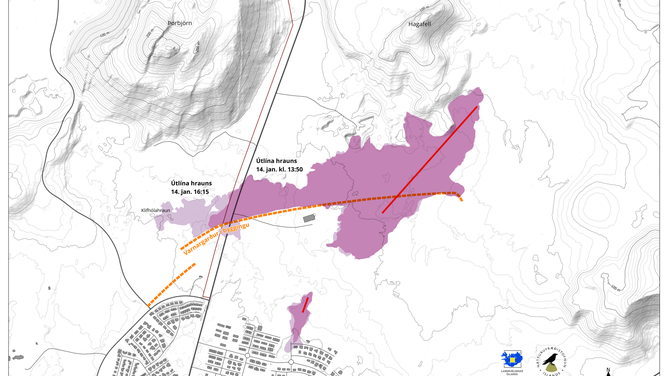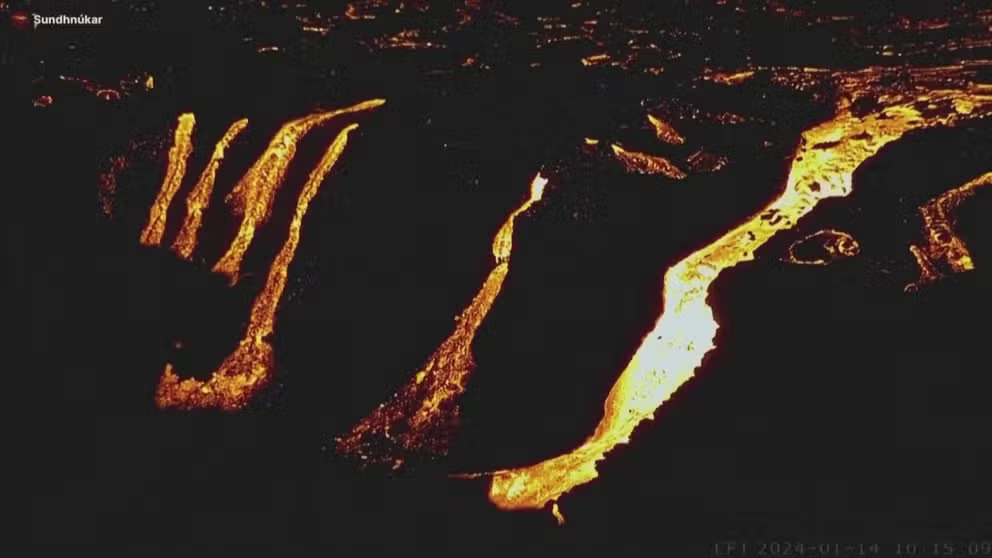Drone video shows burning home in pool of glowing lava in Iceland
This eruption comes on the heels of a December eruption, which triggered an evacuation.
Dramatic aerial video of Iceland volcano
Drones and airplane passengers caught video of the glowing lava from the Iceland volcano burning paths across the country, forever changing it.
GRINDAVIK, Iceland – This home was no match for lava in Grindavik, Iceland, on Sunday. A secondary fissure opened up inside the protective barriers, allowing lava to flow into the town.
The latest volcanic eruption on the island nation started around 3 a.m away from the city on Sunday, preceded by a massive earthquake swarm, according to an eyewitness. Crews quickly evacuated about 200 people from the town, according to local media. Around noon, another fissure erupted without warning, less than a football field away from the town, according to the IMO.
The entire town of around 4,000 had been previously evacuated before the December 18-21, 2023 eruption.
DRONE VIDEO SHOWS LARGE CRACK SPLITTING ICELANDIC TOWN'S STREET AMID VOLCANIC THREAT

The dark represents the extent of the lava at 1:50 p.m. on Sunday which flowed from the solid red lines which are the eruptive fissures. The light purple shows the progress of lava 2.5 hours later. The dotted orange lines are the town's protective barriers.
(Icelandic Met Office / FOX Weather)
"It's tough in many ways, but I am optimistic by nature, and I try to maintain optimistic. But, you know, this is big, this is serious, it's basically as bad as it can possibly get. Although it might get even worse, who knows," evacuated resident Jon Gauti Dagbjartsson told Reuters. "So, I mean, I'm born in this town, I actually live in the house that I'm born in and it's a tough thought to think that this town might be over, and I would have to start all over somewhere else. But if that's the case, then that's exactly what we'll do."
Eruption without warning
"The eruption sites are extremely hazardous, and the possibility of new fissures emerging without warning cannot be dismissed," wrote the Icelandic Met Office. "This was demonstrated by the eruptive fissure that appeared near the border of Grindavík yesterday, which provided no recognizable warning signs on the monitoring equipment."
At least three homes have burned, according to local media. The IMO stated that additional fissures are possible over the next several days. This is the first time in 51 years that lava flowed into homes in Iceland, according to President Kristjan Eldjarn.
"It is difficult to estimate how long this eruption will last," said the IMO. "Seismic activity has decreased, and GPS measurements indicate that the rate of deformation in the area has reduced. However, deformation is still detected near the southernmost part of the magma conduit beneath Grindavík."
Video shows lava destroying homes in Grindavik after volcanic eruption in Iceland
Dramatic video shows homes being destroyed by a lava flow in the town of Grindavik in Iceland after a volcano erupted early Sunday morning.
The evacuated residents could only watch live feeds on social media to keep track of their homes.
"I am devastated by today's event. I considered not posting images that show terrible tragedy to people’s homes," Björn Steinbekk, who is on Instagram at @bsteinbekk, said in a post on social media platform X, formerly Twitter.
"These images are posted to bring you the dark side of volcanoes," Steinbekk wrote on Instagram at @bsteinbekk. "Almost 4,000 people are suffering right now; some have been watching their houses burn during live feeds and on YouTube."
At this point, the eruption's effects are only localized. Services, like air travel, around the country are all operating normally, stated the visitors' bureau.
Second eruption in as many months
"Since October 24, 2023, scientists at the Icelandic Met Office have been carefully monitoring increased seismic activity on the Reykjanes Peninsula, which is considered a possible precursor to a volcanic eruption in the area," wrote the bureau. "This development resulted in a short eruption that lasted from December 18-21, 2023."
The Reykjanes Peninsula has seen four eruptions in the past three years, five since 2021. Before 2021, volcanoes only erupted in Iceland an average of every five years.
CAN ONE VOLCANO'S ERUPTION TRIGGER AN ERUPTION AT ANOTHER VOLCANO?
"The area broadly known as Fagradalsfjall, some 35km (21 miles) from the capital Reykjavík, flared to life after a series of earthquakes on the Reykjanes Peninsula," wrote the bureau. "The three eruptions - some consider one single eruption with months-long pauses - mark the beginning of a new geological era on the southwestern peninsula, which has been dormant for the past 800 years."
Iceland sits on the Mid-Atlantic Ridge where the North American and Eurasian tectonic plates diverge, making it one of the most active volcanic regions in the world, states the bureau. So, Iceland is no stranger to minor to major earthquakes. Many of the quakes occur due to the movement of the 2,000-degree magma under the surface and plate tectonics.
Editor's note: The drone video originally featured in this story has been removed after permission to feature the video was withdrawn by the source.







